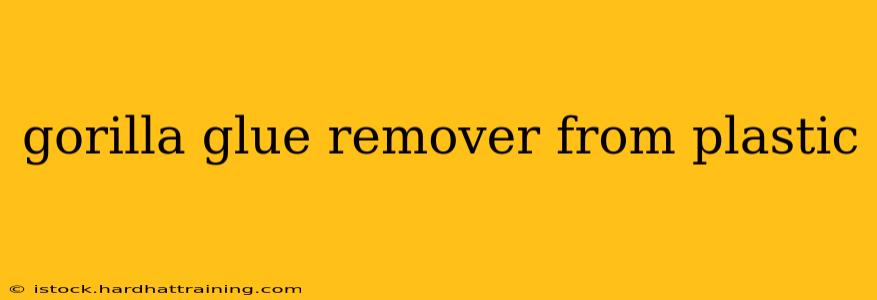Gorilla Glue's incredible strength is a blessing for many projects, but it can quickly become a curse if accidentally applied to plastic. That super-strong bond can seem impossible to break, leaving you with a sticky, frustrating mess. But don't despair! This guide explores effective methods for removing Gorilla Glue from plastic, minimizing damage to your valuable items.
Understanding the Gorilla Glue Challenge
Before diving into removal methods, it's crucial to understand why Gorilla Glue is so difficult to remove from plastic. Its polyurethane formula expands as it cures, creating a tenacious bond that penetrates the surface of the plastic. This makes simple scraping or wiping ineffective. The type of plastic also plays a role; some plastics are more susceptible to damage from harsh solvents.
Choosing the Right Removal Method: A Step-by-Step Approach
The best method for removing Gorilla Glue from plastic depends on several factors, including the type of plastic, the amount of glue, and the surface area affected. Always test any cleaning solution on an inconspicuous area first to ensure it doesn't damage or discolor the plastic.
1. The Gentle Approach: Freezing and Scraping
For smaller glue spots, freezing can be surprisingly effective. Place the plastic item in a freezer for several hours to allow the glue to become brittle. Once frozen, carefully use a plastic scraper (a credit card works well) to gently chip away at the solidified glue. Avoid applying too much pressure to prevent scratching the plastic.
2. Chemical Solvents: Proceed with Caution
Several chemical solvents can help dissolve Gorilla Glue, but they must be used with extreme care. Always work in a well-ventilated area, wear protective gloves and eye protection, and follow the manufacturer's instructions precisely.
- Acetone: A powerful solvent, acetone can effectively dissolve Gorilla Glue. However, it can also damage some plastics, so test it on a hidden area first. Apply acetone with a cotton swab or soft cloth, gently rubbing the glue to loosen it. Wipe clean with a clean cloth.
- Isopropyl Alcohol (Rubbing Alcohol): A milder solvent than acetone, isopropyl alcohol is generally safer for plastics but may require repeated applications. Soak a cotton ball or cloth in isopropyl alcohol and gently rub the affected area. Repeat as needed.
- Denatured Alcohol: Similar to isopropyl alcohol, denatured alcohol is another relatively safe option to try. Again, test on a hidden area first.
3. Commercial Gorilla Glue Removers: A Convenient Option
Gorilla Glue itself offers a remover specifically designed to break down its adhesive. Following the instructions on the remover's packaging is crucial for successful and safe removal.
Preventing Future Gorilla Glue Accidents
Prevention is always better than cure. To avoid future Gorilla Glue mishaps on plastic items:
- Use masking tape: Protect surrounding areas with masking tape before applying Gorilla Glue.
- Work in a controlled environment: Ensure a clean and organized workspace to minimize accidental spills.
- Apply sparingly: Use only the amount of glue necessary for your project.
Conclusion: Patience and Precision are Key
Removing Gorilla Glue from plastic can be a challenging task, but with patience, precision, and the right approach, it's entirely possible. Remember to prioritize safety, always test cleaning solutions beforehand, and choose the method best suited to your specific situation. With careful attention, you can restore your plastic items to their former glory.
